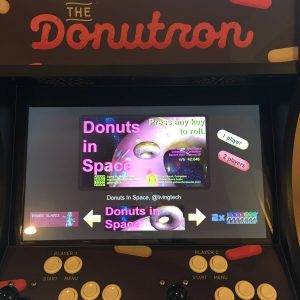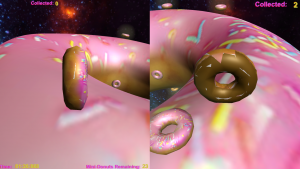I’ve participated in a number of game jams over the last ~7 (or so) years. For the most part, these only get posted somewhere online when either it’s part of the process of “completing the jam”, or if I’m working with a team, and someone else takes the helm. I’ve decided I should be keeping track of these somewhere, and that place is, for the moment, organized chronologically below.
- I first attended 360iDev in 2011, and participated in the overnight (13 hr) game jam there. As near as I can tell/remember, I made a real-time, abstract-board-game-inspired, iPad game I called ColorWheel. (The code was native iOS.) I wrote-up the experience in the second-half of this blog post.
- I did my first Global Game Jam (GGJ) in 2012, creating a board game (with actual artwork by August Brown!) that weekend called Eat Thyself. The theme of the jam was an image of an ouroboros.
- I went back to 360iDev again in fall of 2012, and collaborated with another developer, Levi Brown, to make an iPhone puzzle game called Cloud Growth.
- In 2013, my Global Game Jam entry (which somehow didn’t make it to the GGJ website) was a card game with app component, I called Heart Burn. I write a bunch about it here. August Brown again supplied some artwork, although I’m not sure how much of it saw the light of day.
- In January 2014, I participated in the Global Game Jam with a bunch of other IGDA Twin Cities regulars, and (I believe) this was the first time I’d worked in Unity. There were so many of us (9!) that we actually made 4 games, (almost 5), and bundled them up as Saga of Candy Friends. (A name influenced by King.com trying to trademark/copyright “saga” in a game’s title around that time.) They were all local multiplayer games. As the person least familiar with Unity, I played pickup, and ended up working on a bunch of the games. I was most proud of (and probably spent the most time on) the one called bird drop. Afterwards, I wrote a postmortem on this blog.
- For the 2015 Global Game Jam, I created a block-matching game for the L3D cube called Match-L3D. The L3D is an 8x8x8 cube of LEDs, and really has to be seen to appreciate. I really liked this game, but because it requires the custom hardware (and an xbox360 gamepad, as well as a computer to drive it), I doubt there are more than a handful of people who have played it.
- Not quite a game jam, but my 2016 new year’s resolution was to come up with a new game idea every day. I did this pretty faithfully through about mid-july, and didn’t truly give up on the idea until sometime in September. I wrote up weekly recaps through July 15th (28 of them!), and fully intended to categorize every idea and do a summary post for the whole year at the end of it. I’ve got a spreadsheet that categorizes the first 130 ideas (through week 13), and someday maybe I’ll finish that project.
- My 2016 Global Game Jam game was called Life is Hard. It was very shortly after my decision to take development with Unity more seriously, and I teamed up with August Brown, Mike Manor, and Jason Pfitzer to create a set of 3 or 4 (I can’t remember how many of the ideas we got to) mini-games around menial daily tasks. I was the only programmer, but learned a lot about Unity’s animation system from Jason, who did most of the art.
- I also took part in the Midwest Game Jam in 2016, creating a VR game (targeting HTC Vive) with two other developers in 24 hours, that we called IndustriElf. You play as an elf assembling toys in Santa’s workshop.
- In 2017, I didn’t have time to fully participate in the Global Game Jam, but I brought my 6-year old daughter to the Friday night brainstorm, and we made a little bubble-popper game called Bubble Jumper with only a few additional hours on Saturday. The game was entirely the realization of her ideas, and her wireframes (which we didn’t fully implement) were especially great.
- I participated in #NanoGenMo and #ProcJam in November 2017, by working on a piece of generative interactive fiction using a python script to generate Inform7 source code.
- My 2018 GGJ game was another collaboration with August Brown, a very cute looking tetromino-placement puzzle game called Tetro Buddies. (The name was courtesy of my 9 year old niece Weather.)
- Most recently, (two or three weekends ago, as of this post), I worked on a game in Pico-8 for the 2018 Midwest Game Jam called Emergent Sea (playable if you click through, but read the instructions posted below the cartridge first). The team was four programmers including myself, Scott Lembcke (who also did the art!), Ben Gartner (who also made the music!), and Chris Phan (who contributed a ton, especially considering this was his first game and game jam!). It was my first time really writing anything in Lua, and I rather liked it. The theme for the jam was: emergence (but the game’s name pun credit goes to Scott).
Also, here is my Global Game Jam profile. Other random jam-related profiles: I have one at one game a month (though I haven’t really used it in years), and grid.itch.io, which only has one game-jam game on it. (Though someday I hope/plan to post more there.)
I think I found them all, but who knows. In the future I’d like to make a “page” out of this list, and link it somewhere more prominently. (Maybe with images from each of the games!) I’ll add a link/note here if I do that, for posterity.


